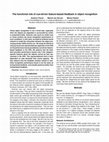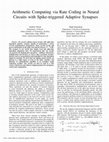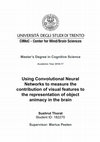Papers by Sushrut Thorat

Visual object recognition is not a trivial task, especially when the objects are degraded or surr... more Visual object recognition is not a trivial task, especially when the objects are degraded or surrounded by clutter or presented briefly. External cues (such as verbal cues or visual context) can boost recognition performance in such conditions. In this work, we build an artificial neural network to model the interaction between the object processing stream (OPS) and the cue. We study the effects of varying neural and representational capacities of the OPS on the performance boost provided by cue-driven feature-based feedback in the OPS. We observe that the feedback provides performance boosts only if the category-specific features about the objects cannot be fully represented in the OPS. This representational limit is more dependent on task demands than neural capacity. We also observe that the feedback scheme trained to max-imise recognition performance boost is not the same as tuning-based feedback, and actually performs better than tuning-based feedback.
In this paper, we outline an approach to build graph-based reverse dictionaries using word defini... more In this paper, we outline an approach to build graph-based reverse dictionaries using word definitions. A reverse dictionary takes a phrase as an input and outputs a list of words semantically similar to that phrase. It is a solution to the Tip-of-the-Tongue problem. We use a distance-based similarity measure, computed on a graph, to assess the similarity between a word and the input phrase. We compare the performance of our approach with the Onelook Reverse Dictionary and a distribu-tional semantics method based on word2vec, and show that our approach is much better than the distributional semantics method, and as good as Onelook, on a 3k lexicon. This simple approach sets a new performance baseline for reverse dictionaries. 1

We present spiking neural circuits with spike-time dependent adaptive synapses capable of perform... more We present spiking neural circuits with spike-time dependent adaptive synapses capable of performing a variety of basic mathematical computations. These circuits encode and process information in the spike rates that lie between 40-140Hz. The synapses in our circuit obey simple, local and spike-time dependent adaptation rules. We demonstrate that our circuits can perform the fundamental operations - addition, subtraction, multiplication and division, as well as other non-linear transfor mations such as exponentiation and logarithm for time dependent signals in real-time. We show that our spiking neural circuits are tolerant to a high degree of noise in the input variables, and illustrate its computational capability in an exemplary signal estimation problem. Our circuits can thus be used in a wide variety of hardware and software implementations for navigation, control and computation.
Thesis Chapters by Sushrut Thorat

A mediolateral gradation in neural responses for images spanning animals to artificial objects is... more A mediolateral gradation in neural responses for images spanning animals to artificial objects is observed in the ventral temporal cortex (VTC). Which information streams drive this organisation is an ongoing debate. Recently, in Proklova et al. (2016), the visual shape and category (“animacy”) dimensions in a set of stimuli were dissociated using a behavioural measure of visual feature information. fMRI responses revealed a neural cluster (extra-visual animacy cluster - xVAC) which encoded category information unexplained by visual feature information, sug- gesting extra-visual contributions to the organisation in the ventral visual stream. We reassess these findings using Convolutional Neural Networks (CNNs) as models for the ventral visual stream. The visual features developed in the CNN layers can categorise the shape-matched stimuli from Proklova et al. (2016) in contrast to the behavioural measures used in the study. The category organisations in xVAC and VTC are explained to a large degree by the CNN visual feature differences, casting doubt over the suggestion that visual feature differences cannot account for the animacy organisation. To inform the debate further, we designed a set of stimuli with animal images to dissociate the animacy organisation driven by the CNN visual features from the degree of familiarity and agency (thoughtfulness and feelings). Preliminary results from a new fMRI experiment designed to understand the contribution of these non-visual features are presented.
The dynamics of a quadcopter are unstable and non-linear. As a result, the quadcopters flight rel... more The dynamics of a quadcopter are unstable and non-linear. As a result, the quadcopters flight relies heavily on the Flight controller. Here we present a robust control scheme which can act as the flight controller for the quadcopter. We then describe a scheme to translate this scheme into a Spiking Neural Network using a modular approach.
For further comments, visit - http://goo.gl/mkYehR







Uploads
Papers by Sushrut Thorat
Thesis Chapters by Sushrut Thorat
For further comments, visit - http://goo.gl/mkYehR
For further comments, visit - http://goo.gl/mkYehR